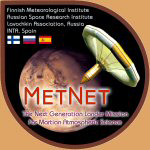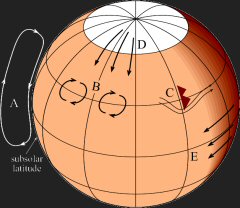
Definition of science objectives
Since many meteorological and climatological phenomena have both temporal and spatial variations in scales ranging from local to global and from sub-diurnal to multi-annual, characterisation of such phenomena require ideally simultaneous observations at multiple and different locations and over a sufficiently long period of time. Hence a surface network combined with an orbiting sounder is the preferred and closest-to-ideal means of observation. The spatial coverage and distribution of the network as well as the types, temporal durations and resolutions of the instruments and observations need to be commensurate with the characteristic spatial and temporal scales of the phenomena being observed. The need for such a mission concept has been obvious for a long time and several surface networks of varying coverage and complexity have been proposed in different contexts (Haberle and Catling, 1996; Barnes et al, 1993; Squyres, 1995; Harri et al, 1999). No Martian surface network has been deployed to date, however.
The number of the in situ payloads and their locations on the planetary surface play an essential role in the mission planning process, as documented by, e.g. Grant et al (2004). When addressing local and regional scale atmospheric behavior with one or few surface payloads, the observation posts should be located on areas with, e.g. variable types of geography, terrain, thermal inertia, altitude, as well as surface materials and albedo. Capturing synoptic and largescale atmospheric flows and global circulation phenomena requires a number of simultaneously operating observation posts located around the planetary surface. At least of the order of ten to twenty observation posts are required to address planet-wide atmospheric phenomena as also pointed out by e.g. Haberle and Catling (1996). The MetNet Mission will be fit in nicely in this mission category.
The MetNet mission goal is to comprehensively address the objectives outlined above by means of deploying a primarily global-scale, multi-point surface observation network supplemented by an orbiting atmospheric remote sounder operating at least for two Martian years.
Primary and additional scientific objectives
An itemised breakdown of the primary science objectives of the MetNet mission is the following:



